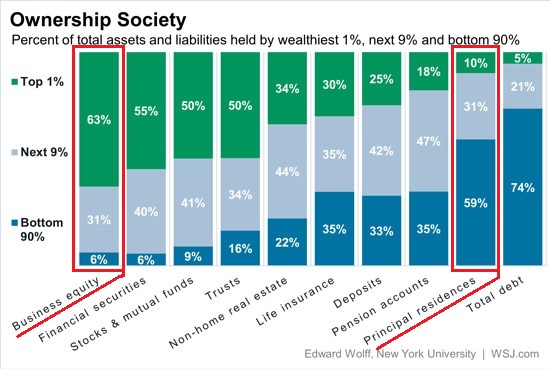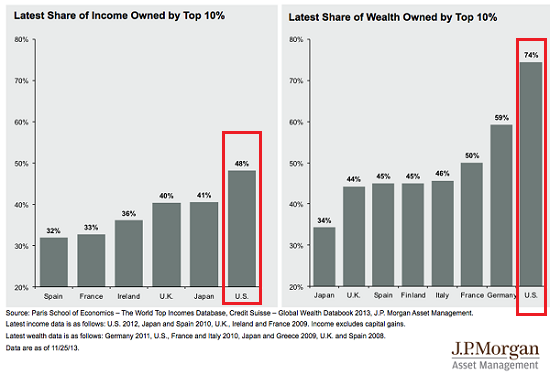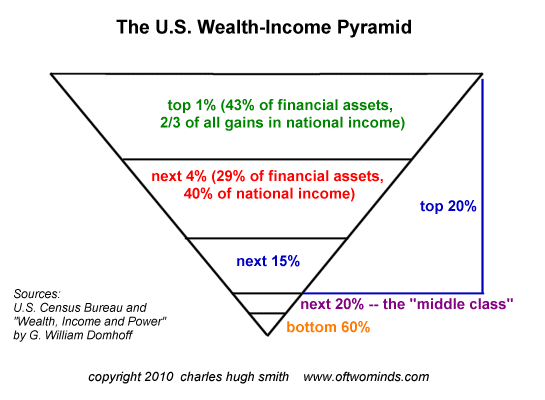What’s left unsaid is much of the upper middle class is prospering due to privileged positions that are increasingly at risk of disruption.
What does it take to be upper middle class? According to one analyst, the answer is: at least $100,000 a year for a family of three. The Growing Size and Incomes of the Upper Middle Class (Urban Institute).
The paper claims the upper middle class has grown from 12.9% of the population in 1979 to 29.4% in 2014–in essence, the shrinkage of the “middle class” is not just from households dropping down the ladder but millions of households climbing up to the upper middle class.
Not Just the 1%: The Upper Middle Class Is Larger and Richer Than Ever (WSJ.com)
While the evidence broadly supports this secular shift–the concentration of income and wealth in the top 20% increases while the wealth and income of the bottom 80% stagnates–I think the claim that 30% of all U.S. households are upper middle class grossly overstates the reality, which is it’s become increasingly costly to even qualify as middle class, never mind upper middle class.
I’ve explored these topics in depth over the past few years:
How Many Slots Are Open in the Upper Middle Class? Not As Many As You Might Think (March 30, 2015)
What Does It Take To Be Middle Class? (December 5, 2013)
If we measure financial characteristics of middle class status rather than income, we find $100,000 is borderline middle class, not upper middle class. The above essay lists the baseline of 10 minimum metrics of middle class status. In high-cost regions, $100,000 barely qualifies a household as middle class; to be upper middle class, households must earn closer to $200,000.
A household income of $190,000 is in the top 5% nationally. According to the Social Security Administration data for 2013 (the latest data available), individuals who earn $125,000 or more are in the top 5% of all earners. Two such workers would earn $250,000 together. The 2.8 million households with incomes of $250,000 or more are in the top 2.5%.
I think it is reasonable to define the 12% of households earning between $125,000 (top 15%) and $350,000 (the cut-off for the top 1%) as upper middle class. This is around 14.5 million households, out of a total of 121 million households.
| This is a far cry from 30% of all households qualifying as upper middle class. What we’re seeing is the inflation of “middle class” to “upper middle class,” just as a B grade is now an A, and jobs that don’t require a university degree now nominally require a bachelors degree or higher.
The increasingly desperate effort to reach the upper middle class is evidenced by a slew of books and articles on what it takes to succeed in an increasingly winners-take-all economy, and on the anxieties of those trying to “make it”: note that most of the articles are published in magazines/media outlets that appeal to the very upper middle class that’s anxious about maintaining their tenuous hold on prosperity: How to Save Like the Rich and the Upper Middle Class (Hint: It’s Not With Your House) (WSJ.com) The Hidden Cost for Stay-At-Home American Parents (Bloomberg) The War on Stupid People: American society increasingly mistakes intelligence for human worth (The Atlantic) The Limits of “Grit” (New Yorker) The Talent Code: Greatness Isn’t Born. It’s Grown. Here’s How. (via Ron G.) The Geography of Genius: A Search for the World’s Most Creative Places from Ancient Athens to Silicon Valley (via Ron G.) Grit: The Power of Passion and Perseverance (book) I’ve laid out my own bootstrap blueprint in Get a Job, Build a Real Career and Defy a Bewildering Economy (hint: don’t cling to credentials and privilege as your strategy–acquire skills and entrepreneurial income streams).
|
Ownership Society |
| What’s left unsaid in all these articles is much of the upper middle class is prospering due to privileged positions that are increasingly at risk of disruption–a topic I discussed in If You Want More Jobs and More Job Stability, Disrupt More, Not Less (June 21, 2016) and How Many Law Schools Need to Close? Plenty (June 20, 2016). |
Latest Share of Owned by Top 10% |
| And just a reminder: of the supposed 30% of households who are upper middle class, only the top 10% have significant wealth-building assets: that tells us in no uncertain terms that two-thirds of the supposedly upper middle class 30% are only middle class. |
The U.S. Wealth-Income Pyramid |
See more for



















